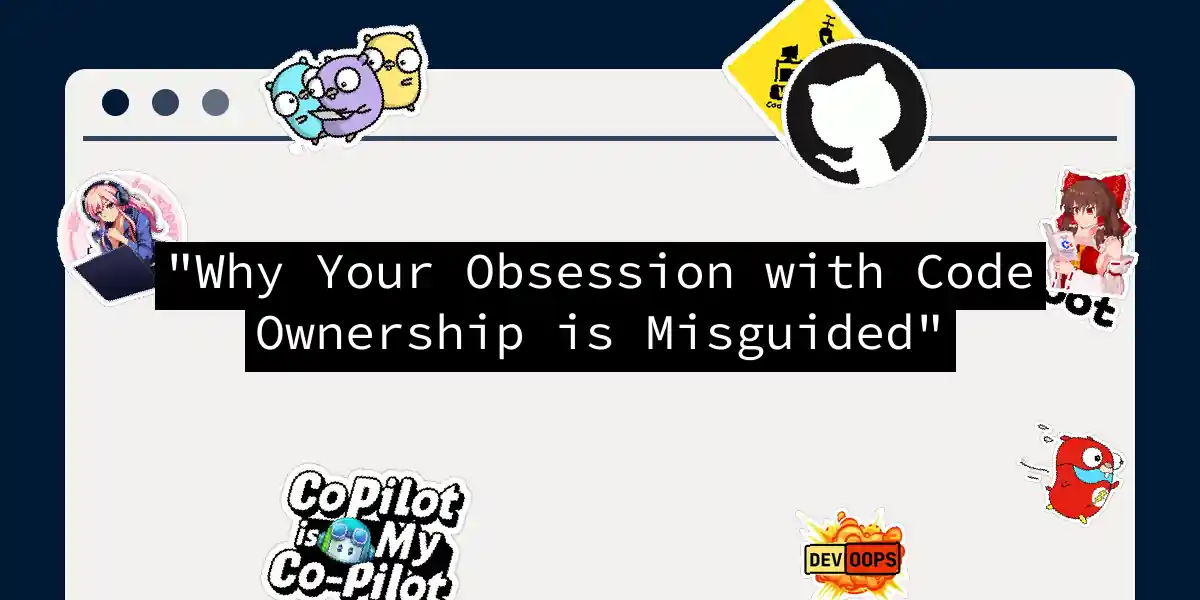Code ownership. That sacred cow in many teams’ philosophies. It’s the idea that one developer owns a piece of code like a territorial dog guarding its chew toy. But what happens when that dog gets distracted by a squirrel? Or worse—leaves the pack entirely? Let me repeat that: code ownership is not about proprietorship, but about shared responsibility. Think of it as collaborative cooking rather than a private five-course meal. Let’s dissect why this obsession with ownership creates more problems than it solves.
The Problem with Code Ownership
Silos create tech debt
When a developer “owns” a module, they become the sole gatekeeper. It leads to knowledge silos where one person’s vacation = code paralysis[1][3]. Remember the bus factor? Imagine your team’s productivity screeching to a halt because the code owner is temporarily indisposed (or simply burned out). This isn’t efficient—it’s a hostage situation in code form.
Ownership breeds defensiveness
Ever seen a developer guard their code like it’s their secret recipe? You get comments like “Don’t touch my API!” or “I need to approve every change.” This creates:
- Bottlenecked workflows: Progress depends on a single person’s availability
- Complacency: Without external reviewers, quality control suffers[5]
- Stunted growth: Developers avoid learning new parts of the system
Ownership limits learning opportunities
In some teams, new developers get stuck in “safe zones” where they only work on their “assigned” modules. This is like training a musician to only play the instrument they know—their potential remains limited. Collective ownership forces developers to explore the entire codebase, making them more versatile[3].
This diagram illustrates the predictable chaos when code ownership meets reality.
The Dark Side of Collective Ownership
But let’s not romanticize collective ownership. Without clear guidelines, it becomes anarchy:
- Inconsistent implementations: A module gets written five different ways[3]
- Blame games: “It was broken when I found it!” becomes the team’s motto
- Tragedy of the commons: Developers might ignore refactoring if “somebody else” can do it[3]
So how do we strike balance? Enter weak code ownership—where modules have recognized experts (owners) but anyone can suggest changes. It’s like having a Wikipedia editor: you might focus on certain articles, but anyone can contribute.
A Better Approach: Shared Responsibility with Guardrails
1. Establish code ownership roles
- Name a “primary maintainer” for critical components
- Ensure cross-training: Every owner should have at least one backup
- Use shared documentation to reduce knowledge gaps:
This flow ensures expertise is leveraged while allowing contributions.
2. Institute code review culture
- Mandatory reviews for changes in owned areas
- Rotate reviewers to distribute knowledge
- Keep review feedback constructive:
- Bad: “You should have used X pattern”
- Good: “Why did you choose this approach? Could we improve…”
3. Automate knowledge sharing
- Wiki pages documenting architectural decisions
- Technical debt reports visible to all
- Refactoring sprints where everyone touches other modules
The Measured Codebase: Where Expertise Meets Collaboration
Key man dependency becomes a non-issue when your team practices pair programming and spike investigations across modules. For example:
- Spike rotations:
- Developer A explores Module X this week
- Developer B takes it next week
- Emergency preparedness:
- Cross-training sessions every month
- Detailed runbooks for critical systems
This approach turns ownership from a liability to a strategy. Instead of hoarding knowledge, you’re catalyzing learning.
The real tragedy isn’t code ownership itself—it’s treating it as an absolute rather than a flexible construct. Your codebase should feel like a multiplayer game, not a solitary puzzle.
Final Thought: Code ownership isn’t inherently evil. What’s dangerous is when it becomes a culture of possessiveness rather than collaboration. The healthiest teams don’t have “my code”—they have “our code” visited by multiple contributors. Ditch the dog-eat-dog mentality. The best systems thrive on shared responsibility, not territorial claims. Now go debate this in your team. The future of your codebase depends on it.
